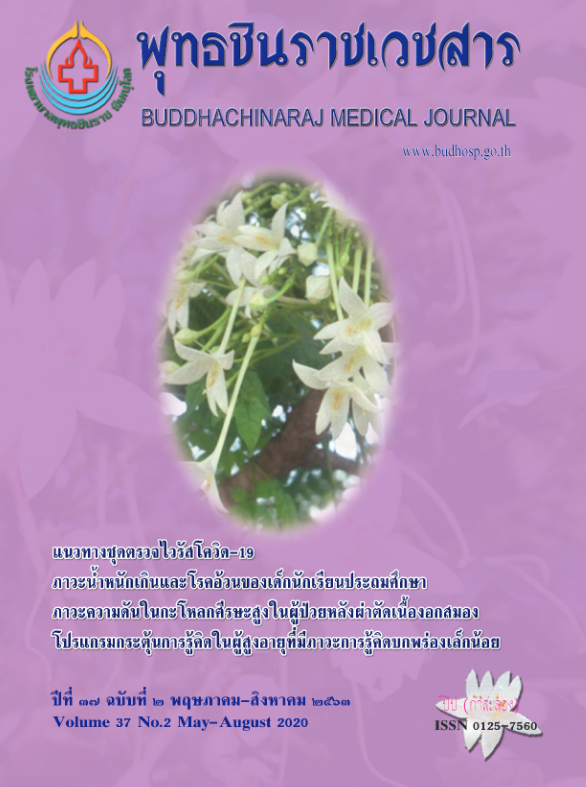แนวทางชุดตรวจสำเร็จไวรัสก่อโรคโควิด-19แนวทางชุดตรวจสำเร็จไวรัสก่อโรคโควิด-19
แนวทางชุดตรวจสำเร็จโควิด-19
คำสำคัญ:
โควิด-19, ชุดตรวจสำเร็จ, การวินิจฉัยในหลอดทดลอง (ภายนอกร่างกายมนุษย์)บทคัดย่อ
ไวรัสโควิด-19 (severe acute respiratory syndrome coronavirus 2: SARS-CoV-2) ก่อให้เกิดโรคติดต่อ coronavirus disease 2019 (COVID-19) ที่กำลังระบาดในประเทศไทยและทั่วโลก โดยมีอัตราการแพร่กระจายโรคสูงมาก ดังนั้นการพัฒนาวิธีตรวจวินิจฉัยโรคให้สามารถเข้าถึงในระดับภาคสนามและท้องถิ่นรวดเร็วและราคาไม่แพงจึงเป็นสิ่งจำเป็นที่จะช่วยหยุดยั้งการแพร่ ระบาดของโรค ในปัจจุบันการตรวจวินิจฉัยไวรัสก่อโรคโควิด-19 ด้วยวิธีมาตรฐานระดับห้องปฏิบัติการคือ RT-qPCR ซึ่งมีความ จำเพาะและแม่นยำ แต่ต้องอาศัยผู้เชี่ยวชาญเครื่องมือมีราคาสูง และใช้ระยะเวลาวิเคราะห์ค่อนข้างนาน ดังนั้นการคิดค้นพัฒนาชุด ตรวจสำเร็จจึงเป็นอีกหนึ่งหนทางที่ช่วยให้การวินิจฉัยโรคโควิด-19 ไดร้ วดเร็วและทั่วถึง ซึ่งปัจจุบันได้วิจัยและพัฒนาชุดตรวจสำเร็จจำหน่ายโดยแบ่งเป็นการตรวจสารพันธุกรรมในสารคัดหลั่งทางเดินหายใจและการตรวจหาภูมิคุ้มกันในเลือดของผู้ป่วยบทความนี้ได้นำเสนอข้อมูลและรายละเอียดของหลักการพัฒนาชุดตรวจสำเร็จไวรัสก่อโรคโควิด-19 สนับสนุนความเข้าใจในการ ตรวจวินิจฉัยโรค รวมถึงข้อสนเทศเกี่ยวกับชุดตรวจสำเร็จและแนวทางนำไปสู่การพัฒนาชุดตรวจสำเร็จไวรัสก่อโรคโควิด-19 ที่มี ประสิทธิภาพต่อไป
เอกสารอ้างอิง
2. Viral Zone. SARS coronavirus 2 (SARS-CoV-2) proteome [online]. 2020 [cited 2020 May1]. Available from: https://viralzone.expasy.org/8996
3. Zhou P, Yang XL, Wang XG, Hu B, Zhang L, Zhang W, et al. A pneumonia outbrea kassociated with a new coronavirus of probable bat origin. Nature 2020;579(7798):270-3.
4. Perlman S, Netland J. Coronaviruses post-SARS: Update on replication and pathogenesis. Nat Rev Microbiol 2009;7(6):439-50.
5. Drosten C, Gunther S, Preiser W, van der Werf S, Brodt HR, Becker S, et al. Identification of a novel coronavirus in patients with severe acute respiratory syndrome. N Engl J Med 2003;348(20):1967-76.
6. World Health Organization. Consensus document on the epidemiology of severe acute respiratory syndrome (SARS) [online]. 2020 [cited 2020 May 1]. Available from:https://www.who.int/csr/sars/WHOconsensus.pdf?ua=1
7. WHO Mers-Cov Research Group. State of knowledge and data gaps of middle east respiratory syndrome coronavirus (MERS-CoV) in humans. PLoSCurr 2013;5. doi:10.1371/currents.outbreaks.0bf719e352e7478f8ad85fa30127ddb8
8. Oboho IK, Tomczyk SM, Al-Asmari AM, Banjar AA, Al-Mugti H, Aloraini MS, et al. 2014 MERS-CoV outbreak in Jeddah--a link to health care facilities. N Engl J Med 2015;372(9):846-54.
9. Rolling updates on coronavirus disease (COVID-19) [online]. 2020 [cited 2020 May 1]. Available from: https://www.who.int/emergencies/diseases/novel-coronavirus-2019/events-as-they-happen
10. Fan Y, Zhao K, Shi ZL, Zhou P. Bat coronaviruses in China. Viruses 2019;11(3):210. doi:10.3390/v11030210
11. Udugama B, Kadhiresan P, Kozlowski HN, Malekjahani A, Osborne M, Li VYC, et al. Diagnosing COVID-19: The disease and tools for detection. ACS Nano 2020;14(4):3822-35.
12. Li Q, Guan X, Wu P, Wang X, Zhou L, Tong Y, et al. Early transmission dynamics in Wuhan, China, of novel coronavirusinfected pneumonia. N Engl J Med 2020;382(13):1199-207.
13. Wang Y, Wang Y, Chen Y, Qin Q. Unique epidemiological and clinical features of the emerging 2019 novel coronavirus pneumonia (COVID-19) implicate special control measures. J Med Virol 2020. doi:10.1002/jmv.25748
14. Wang Z, Ma W, Zheng X, Wu G, Zhang R. Household transmission of SARS-CoV-2. J Infect 2020. doi:https://doi.org/10.1016/j.jinf.2020.03.040
15. Clinical management of severe acute respiratory infection when novel coronavirus (nCoV) infection is suspected: Interim guidance [online]. 2020 [cited 2020 May 1].Available from: https://www.who.int/publications-detail/clinical-management-of-severeacute-respiratory-infection-when-novelcoronavirus-(ncov)-infection-is-suspected
16. Li X, Geng M, Peng Y, Meng L, Lu S. Molecular immune pathogenesis and diagnosis of COVID-19. J Pharm Anal 2020;5. doi:10.1016/j.jpha.2020.03.001
17. Heid CA, Stevens J, Livak KJ, Williams PM. Real time quantitative PCR. Genome Res 1996;6(10):986-94.
18. Chu DKW, Pan Y, Cheng SMS, Hui KPY, Krishnan P, Liu Y, et al. Molecular diagnosis of a novel coronavirus (2019-nCoV) causing an outbreak of pneumonia. Clin Chem 2020;66(4):549-55.
19. Vashist SK. In vitro diagnostic assays for COVID-19: Recent advances and emerging trends. Diagnostics 2020;10(4):202.doi:10.3390/diagnostics10040202
20. Notomi T, Okayama H, Masubuchi H,Yonekawa T, Watanabe K, Amino N, et al. Loop-mediated isothermal amplification of DNA. Nucleic Acids Res 2000;28(12):E63.
21. Srimongkol G, Ditmangklo B, Choopara I, Thaniyavarn J, Dean D, Kokpol S, et al. Rapid colorimetric loop-mediated isothermal amplification for hypersensitive point-ofcare Staphylococcus aureus enterotoxin A gene detection in milk and pork products. Sci Rep 2020;10:7768. doi:10.1038/s41598-020-64710-0
22. Yan C, Cui J, Huang L, Du B, Chen L, Xue G, et al. Rapid and visual detection of 2019 novel coronavirus (SARS-CoV-2) by a reverse transcription loop-mediated isothermal amplification assay. Clin Microbiol Infect 2020. doi:10.1016/j.cmi.2020.04.001
23. Lamb LE, Bartolone SN, Ward E, Chancellor MB. Rapid detection of novel coronavirus (COVID-19) by reverse transcription-loopmediated isothermal amplification. medRxiv 2020. doi:10.1101/2020.02.19.20025155
24. Yu L, Wu S, Hao X, Li X, Ye S, Han H, et al. Rapid colorimetric detection of COVID-19 coronavirus using a reverse transcriptional loop-mediated isothermal amplification (RT-LAMP) diagnostic platform iLACO.medRxiv 2020.doi:10.1101/2020.02.20.20025874
25. Piepenburg O, Williams CH, Stemple DL, Armes NA. DNA detection using recombination proteins. PLoSBiol 2006;4(7):1115-21.
26. Zhang F, Abudayyeh OO, Gootenberg JS. A protocol for detection of COVID-19 using CRISPR diagnostics [online]. 2020 [cited 2020 May 1]. Available from: https://www.broadinstitute.org/files/publications/special/COVID-19%20detection%20
(updated).pdf
27. Broughton JP, Deng X, Yu G, Fasching CL, Singh J, Streithorst J, et al. Rapid detection of 2019 novel coronavirus SARS-CoV-2 using a CRISPR-based DETECTR lateral flow assay. medRxiv 2020. doi:10.1101/2020.03.06.20032334
28. Adams ER, Anand R, Andersson MI, Auckland K, Baillie JK, Barnes E, et al. Evaluation of antibody testing for SARS-Cov-2 using ELISA and lateral flow immunoassays.medRxiv 2020. doi:10.1101/2020.04.15.20066407
29. Li G, Chen X, Xu A. Profile of specific antibodies to the SARS-associated coronavirus. N Engl J Med 2003;349(5):508-9.
30. Sethuraman N, Jeremiah SS, Ryo A. Interpreting diagnostic tests for SARS-CoV-2. JAMA 2020;323(22):2249-51.
31. Li Z, Yi Y, Luo X, Xiong N, Liu Y, Li S, et al. Development and clinical application of a rapid IgM-IgG combined antibody test for SARS-CoV-2 infection diagnosis. J Med Virol 2020. doi:10.1002/jmv.25727
32. Xiang J, Yan M, Li H, Liu T, Lin C, Huang S, et al. Evaluation of enzyme-linked immunoassay and colloidal gold-immuno chromatographic assay kit for detection of novel coronavirus (SARS-Cov-2) causing an outbreak of pneumonia (COVID-19). edRxiv 2020. doi:10.1101/2020.02.27.20028787
33. Green K, Graziadio S, Turner P, Fanshawe T, Allen J. Molecular and antibody pointof-care tests to support the screening, diagnosis and monitoring of COVID-19.CEBM Res 2020. Available from: https://www.cebm.net/covid-19/molecular-andantibody-point-of-care-tests-to-supportthe-screening-diagnosis-and-monitoringof-covid-19/
34. Lv H, Wu NC, Tsang OTY, Yuan M, Perera RA, Leung WS, et al. Cross-reactive antibody response between SARS-CoV-2and SARS-CoVinfections. bioRxiv 2020.doi:10.1101/2020.03.15.993097
35. To KKW, Tsang OTY, Leung WS, Tam AR, Wu TC, Lung DC, et al. Temporal profiles of viral load in posterior oropharyngeal saliva samples and serum antibody responses during infection by SARS-CoV-2: An observational cohort study. Lancet Infect Dis2020. doi:10.1016/S1473-3099(20)30196-1
36. Yan C, Cui J, Huang L, Du B, Chen L, Xue G, et al. Rapid and visual detection of 2019 novel coronavirus (SARS-CoV-2) by a reverse transcription loop-mediated is othermal amplification assay. Clin Microbiol Infect 2020. doi:10.1016/j.cmi.2020.04.001
37. Zhao J, Yuan Q, Wang H, Liu W, Liao X, Su Y, et al. Antibody responses to SARSCoV-2 in patients of novel coronavirus disease 2019. Clin Infect Dis 2020. doi:10.1093/cid/ciaa344






